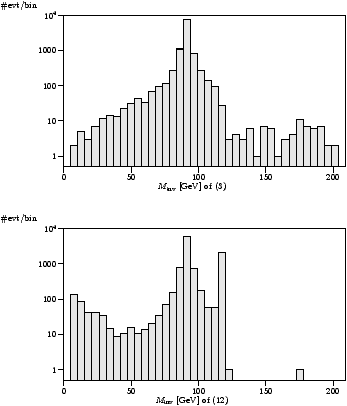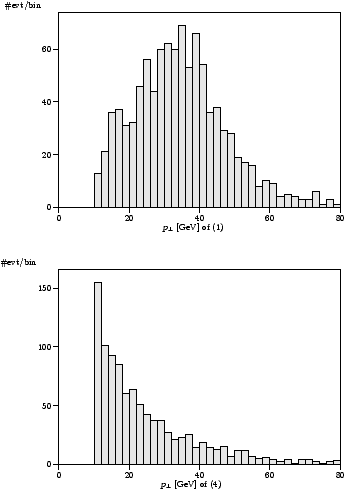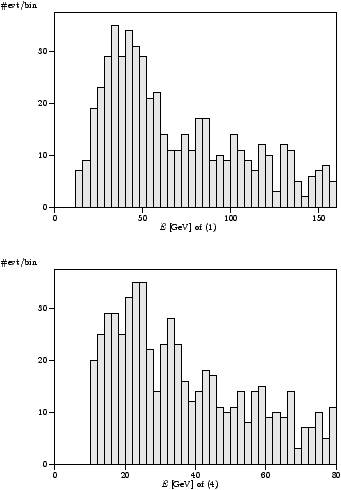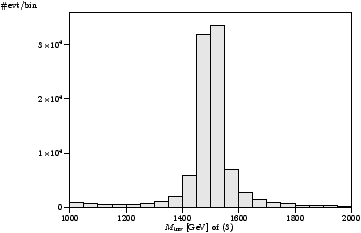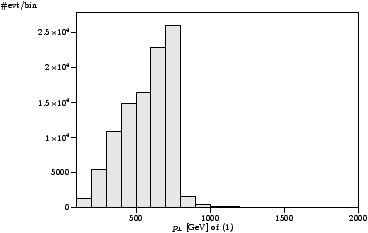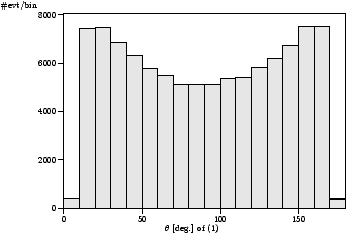


Chapter 6 Examples
In the following sections five realistic applications of WHIZARD are presented: first, three LEP examples, namely, Higgs production in the four-fermion channels, W production (four fermions), and strong WW scattering (six fermions). With certain refinements and modifications, they could be used for actual physical applications. However, here they are intended as a form of tutorial, showing typical setups and common problems. We then switch to two LHC examples, the Jacobian peak or endpoint in W production and Drell-Yan production of a heavy Z′ vector boson. Note that WHIZARD 1 was intended for lepton collider simulations basically, a lot of hadron collider physics does work perfectly with this version, but WHIZARD 2 has been specifically designed for hadron collider physics. So we strongly recommend using WHIZARD 2 in such cases. We nevertheless present the two LHC examples here. 6.1 Higgs production at LEPLet us simulate the production of a 115 GeV Standard Model Higgs in e+e− collisions at 209 GeV. With this mass, the Higgs boson decays mainly into b b with a small fraction of τ+τ− decays. Here, we only consider the signal together with its irreducible background, contributing to the processes
where q=u,d,s,c and ν=νe,νµ,ντ. This list of
processes directly translates into the configuration file
# WHIZARD configuration file # The selected model model SM alias q u:d:s:c alias Q U:D:S:C alias n n1:n2:n3 alias N N1:N2:N3 # Processes # Methods: omega=O'Mega) # Tag In Out Method Option #===================================================== # On-shell process: zh e1,E1 Z,H omega # Full four-fermion matrix elements: nnbb e1,E1 n,N,b,B omega qqbb e1,E1 q,Q,b,B omega c bbbb e1,E1 b,B,b,B omega c eebb e1,E1 e1,E1,b,B omega mmbb e1,E1 e2,E2,b,B omega qqtt e1,E1 q,Q,e3,E3 omega bbtt e1,E1 b,B,e3,E3 omega
Here, we use flavor summation for the quark and missing-energy
channels. After this file has been saved in the > ./configure and make and install the executable > make install After this step is completed, we are ready for running the program. 6.1.1 The on-shell process
All necessary files have now been installed in the > cd results > ls Makefile whizard whizard.cut5 whizard.mdl Makefile.in whizard.cut1 whizard.in whizard.prc
The file &process_input process_id = "zh" sqrts = 209 / &integration_input stratified = F / &simulation_input / &diagnostics_input / ¶meter_input MH = 115 wH = 0.3228E-02 Mb = 2.9 Me = 0 Ms = 0 Mc = 0 / &beam_input / &beam_input /
As a warm-up, we examine the on-shell process e−e+→ ZH, labeled
Having saved > ./whizard
(if you like, you can also type The cross section is2
This calculation takes roughly a minute on a PC (Intel Core2 2.5 GHz, gfortran compiler). Of course, if we invest more CPU time, we can improve the accuracy, as explained in the previous subsection. In inspecting the output, the column tagged Let us now generate events. We define a nonzero luminosity (100 fb−1, which was more than 100 times the LEP integrated luminosity per year): &process_input process_id = "nnbb" sqrts = 209 luminosity = 100 / We do not want to repeat the adaptation and integration steps, therefore we read in the previously adapted grids &integration_input read_grids = T / Now running WHIZARD will result in a repetition of the previous result, before event generation is started: ! Reading analysis configuration data from file whizard.cut5 ! No analysis data found for process nnbb ! Event sample corresponds to luminosity [fb-1] = 100.0 ! Event sample corresponds to 69367 weighted events ! Generating 10656 unweighted events ... ! Event generation finished. !============================================================================= ! Analysis results for process nnbb: ! It Events Integral[fb] Error[fb] Err[%] Acc Eff[%] Chi2 N[It] !----------------------------------------------------------------------------- 13 10656 1.0655809E+02 1.03E+00 0.97 1.00 100.00 !----------------------------------------------------------------------------- ! Warning: Excess events: 7.9 ( 0.07% ) | Maximal weight: 1.25 The generation of 10,656 events takes one more minute in this case. No further analysis has been requested, so we just get the total cross section again. By definition, this is equal to the previously calculated cross section, but the error now corresponds to the actual event sample. There are some excess events (weight greater than one), but the effect
of this excess being dropped is considerably less than the statistical
error of the event sample. If necessary, the excess could be removed
by setting The event sample can be further analyzed: Let us plot the missing invariant mass distribution and the dijet invariant mass distribution, which should exhibit peaks at the Z and Higgs mass. To this end, we tell WHIZARD to reread the generated event sample &simulation_input read_events = T /
and make up an analysis configuration file # cut/histogram configuration file # e- e+ -> nu nubar b bbar # 32 16 1 2 4 8 process nnbb, qqbb, bbbb, eebb, mmbb, qqtt, bbtt histogram M of 3 within 0 209 nbin 40 and histogram M of 12 within 0 209 nbin 40 and cut M of 12 within 114 116 histogram M of 3 within 0 209 nbin 40 This type of analysis can serve for all processes, therefore we have added the other tags. The last histogram counts only those events which have a bb invariant mass close to the Higgs mass. The numbers result from adding up the binary codes of the external particles, which are shown as a the comment in the file header. Running WHIZARD this time takes almost no time since only the previously generated files have to be read: ! Reading analysis configuration data from file whizard.cut5 ! Found 3 analysis configuration datasets. ! Looking for raw event file whizard.evx ... ! Event sample corresponds to luminosity [fb-1] = 100.0 ! Event sample corresponds to 69367 weighted events ! Reading 10656 unweighted events ... ! Event generation finished. !============================================================================= ! Analysis results for process nnbb: ! It Events Integral[fb] Error[fb] Err[%] Acc Eff[%] Chi2 N[It] !----------------------------------------------------------------------------- 13 10656 1.0655809E+02 1.03E+00 0.97 1.00 100.00 !----------------------------------------------------------------------------- ! Warning: Excess events: 7.9 ( 0.07% ) | Maximal weight: 1.25 !============================================================================= ! Analysis results for process nnbb: ! It Events Integral[fb] Error[fb] Err[%] Acc Eff[%] Chi2 N[It] !----------------------------------------------------------------------------- 13 10656 1.0655809E+02 1.03E+00 0.97 1.00 100.00 !----------------------------------------------------------------------------- ! Warning: Excess events: 7.9 ( 0.07% ) | Maximal weight: 1.25 !============================================================================= ! Analysis results for process nnbb: ! ! Additional cuts: ! integration pass 5 cut M of 12 within 1.14000E+02 1.16000E+02 ! It Events Integral[fb] Error[fb] Err[%] Acc Eff[%] Chi2 N[It] !----------------------------------------------------------------------------- 13 2166 2.1659612E+01 4.65E-01 2.15 1.00 20.33 !----------------------------------------------------------------------------- ! Warning: Excess events: 1.5 ( 0.07% ) | Maximal weight: 1.05
From the last line we read off that the actual contribution of Higgs
production in this channel is 2166 events (or 20.33 %). Here
the efficiency is not the reweighting efficiency as before, but the
fraction of events remaining after cuts. The histograms can now be
found in the output file !============================================================================= ! WHIZARD 1.97 (May 31 2011) ! Process nnbb: ! e a-e -> nu_e a-nu_e b a-b ! e a-e -> nu_mu a-nu_mu b a-b ! e a-e -> nu_tau a-nu_tau b a-b ! 32 16 -> 1 2 4 8 ! Analysis results for process nnbb: ! ! Histograms: ! histogram M of 3 within 0.00000E+00 2.09000E+02 nbin 40 2.61250000 0.00000000 0.00000000 0.00000000 7.83750000 1.00000000 1.00000000 0.00000000 13.0625000 2.00000000 1.41421356 0.00000000 18.2875000 3.00000000 1.73205081 0.220852468 23.5125000 4.00000000 2.00000000 0.00000000 28.7375000 7.00000000 2.64575131 0.00000000 33.9625000 10.0000000 3.16227766 0.379512096E-01 39.1875000 13.0000000 3.60555128 0.00000000 44.4125000 20.0000000 4.47213595 0.455956036E-02 49.6375000 28.0000000 5.29150262 0.180557973 54.8625000 36.0000000 6.00000000 0.452075346E-03 60.0875000 49.0000000 7.00000000 0.00000000 65.3125000 63.0000000 7.93725393 0.131335186 70.5375000 72.0000000 8.48528137 0.922046560 75.7625000 154.000000 12.4096736 0.00000000 80.9875000 274.000000 16.5529454 0.00000000 86.2125000 1071.00000 32.7261363 1.47417846 ..... In these histograms, the first column is the bin midpoint. The second column is the number of entries, the third column the statistical error on this number (√N). The fourth column shows the excess events, which introduce an additional error. However, for each bin this contribution is negligible compared to the statistical error which is present anyway. The actual histograms are shown in Fig. 6.1. (For better
illustration, we have changed the linear scale to a logarithmic one;
this is done in the file setup(linear,linear); graphrange (#0.00,#0), (#209.,??); by setup(linear,log); graphrange (#0.00,#.5), (#209.,#1e4); and a subsequent rerun) > make plots
In the dijet invariant mass distribution the Z and Higgs peaks are clearly visible. At low dijet invariant mass there is a tail of continuum bb production. In the missing mass distribution the peak is at the Z mass. 6.1.2 The four-jet channelThere are two four-jet channels
If the light quark masses are set to zero (see the input file above), all light quark channels can be treated in a single run. For unequal masses, flavor summation is not possible, therefore the b channel has to be treated separately. (We can’t set the b mass to zero since this would remove the b Yukawa coupling.) Running the program as before for the process
and 28406 events are generated in this run, 4637 of them within the Higgs mass window. To obtain a finite result, WHIZARD had to insert a cut of 10 GeV
on the dijet invariant mass of the light quarks. This cut is written
into the file ! Automatically generated set of cuts ! Process qqbb: ! e a-e -> u a-u b a-b ! e a-e -> d a-d b a-b ! e a-e -> s a-s b a-b ! e a-e -> c a-c b a-b ! 32 16 -> 1 2 4 8 process qqbb cut M of 3 within 1.00000E+01 1.00000E+99
The cut could be modified either by changing the default value in
&integration_input ... default_jet_cut = 5 /
or by providing a non-empty file The bbbb channel is similar, although the presence of identical particles in the final state makes phase space more complicated. The adaptation again works well and we get
6.1.3 The lepton channelsIn the µ+µ− channel adaptation takes somewhat longer due to the small muon mass, if no cuts are provided. However, the 10 iterations of the adaptation step are sufficient, and in the final integration step, the result
is perfectly stable. With suitable cuts, we can set the muon mass to zero, which as a side effect speeds up the calculation by a factor of two. A more difficult task is to get to a stable result for the cross section of the process
without cuts, but with nonzero electron mass. The default choice for the number of calls and iterations does not suffice here: Apparently, convergence is not reached. One possibility to proceed is to reuse these grids, but do further iterations: &integration_input calls = 1 20000 30 20000 3 20000 read_grids = T / For the first iterations the old results are copied. The additional iterations now find convergence, although the final accuracy and efficiency are not really satisfactory: ..... 28 20000 7.5246100E+03 1.72E+02 2.29 3.24 1.17 29 20000 7.7685827E+03 2.05E+02 2.64 3.73 0.93 30 20000 8.0304810E+03 3.52E+02 4.38 6.19 0.60 31 20000 7.7031026E+03 2.21E+02 2.87 4.06 0.81 !----------------------------------------------------------------------------- ! Integrating (fixed wgts.): 3 samples of 20000 calls ... 32 60000 7.2436310E+03 1.39E+02 1.91 4.69 0.31 2.37 3 !----------------------------------------------------------------------------- To get a more precise result, we should also increase the number of calls per iteration. This costs additional CPU time. Fortunately, there is a shortcut. The problem of this calculation is
the fact that a large part of the cross section comes from the region
of very forward electrons. Furthermore, there is a piece which
corresponds to bbγ* production where the virtual photon
splits into the electron-positron pair. These small regions are
sampled only after several iterations and only then have sufficiently
adapted grids. The mappings built into WHIZARD assume the parameters
&integration_input default_Q_cut = 0 default_mass_cut = 0 / (which actually replaces them by some finite small value), and start again:
This time, the difficult regions are sampled from the beginning. With standard cuts on the electron energies and angles, this process is well-behaved. The extra effort is needed only if we are particularly interested in the events with electron and positron going in the very forward and backward regions, respectively. 6.2 6-fermion production: Higgs pairs
A process which is of interest at a future Linear Collider is
Higgs pair production, which is sensitive to the Higgs trilinear
coupling. A process definition file # WHIZARD configuration file alias q u:d:s:c alias Q U:D:S:C model SM #============================================================= # On-shell process: zhh e1,E1 Z,H,H omega # Full six-fermion matrix elements: qqbbbb e1,E1 q,Q,b,B,b,B omega c For simplicity, we consider only six-quark production where four quarks are b quarks (the main decay channel of the Higgs pair), and the remaining quark pair is light. The input file &process_input process_id = "qqbbbb" sqrts = 500 luminosity = 10000 / &integration_input / &simulation_input / &diagnostics_input / ¶meter_input mH = 115 wH = 0.3228E-02 mb = 2.9 me = 0 ms = 0 mc = 0 / &beam_input / &beam_input /
Without further considerations, we switch into the > ./whizard After the initial message ! WHIZARD 1.97 (May 31 2011) ! Reading process data from file whizard.in ! Wrote whizard.out ! ! Process qqbbbb: ! e a-e -> u a-u b a-b b a-b ! e a-e -> d a-d b a-b b a-b ! e a-e -> s a-s b a-b b a-b ! e a-e -> c a-c b a-b b a-b ! 128 64 -> 1 2 4 8 16 32 ! Process energy set to 500.00 GeV ! Reading vertices from file whizard.mdl ... ! Model file: 54 trilinear vertices found. ! Model file: 54 vertices usable for phase space setup. ! Generating phase space channels for process qqbbbb...
the program needs quite some time for generating the phase space
configuration (this would be faster without flavor summation).
Fortunately, the configuration is written to the file
After this step is finished, a default cut for the light quark pair is inserted and integration is started. ! Phase space: 342 phase space channels generated. ! Scanning phase space channels for equivalences ... ! Phase space: 1368 equivalence relations found. ! Note: This cross section may be infinite without cuts. ! Wrote default cut configuration file whizard.qqbbbb.cut0 ! Note: This cross section may be infinite without cuts. ! Wrote default cut configuration file whizard.qqbbbb.cut0 ! Note: This cross section may be infinite without cuts. ! Wrote default cut configuration file whizard.qqbbbb.cut0 ! Note: This cross section may be infinite without cuts. ! Wrote default cut configuration file whizard.qqbbbb.cut0 ! Wrote phase space configurations to file whizard.phx ! ! Created grids: 342 channels, 14 dimensions with 20 bins ! ! WHIZARD run for process qqbbbb: !============================================================================= ! It Calls Integral[fb] Error[fb] Err[%] Acc Eff[%] Chi2 N[It] !----------------------------------------------------------------------------- ! Reading cut configuration data from file whizard.cut1 ! No cut data found for process qqbbbb ! Using default cuts. cut M of 3 within 1.00000E+01 1.00000E+99 ! Preparing (fixed weights): 1 sample of 100000 calls ... The whole adaptation and integration run takes a considerable amount of CPU time (about one day on an Xeon or Alpha processor). If only one quark flavor were considered, this could be reduced by a factor of four (currently, WHIZARD/O’Mega does not take advantage of the fact that some matrix elements with different flavor content are in fact identical. Such a mechanism, known as cross-flavor common subexpression elimination has been incorporated into WHIZARD 2.). A usable result is already reached after about 10 iterations, with considerable fluctuation around the optimal grid4: Nevertheless, the best grid obtained so far can safely be used for event generation. The final estimate for the integral is 22 300000 1.5716132E+00 6.93E-03 0.44 2.41* 2.80 0.46 3 !----------------------------------------------------------------------------- ! ! Time estimate for generating 10000 unweighted events: 1h 19m 27s However, we don’t need that many events: simulating 10 ab−1 now takes only half an hour: ! Event sample corresponds to luminosity [fb-1] = 0.1000E+05 ! Event sample corresponds to 561275 weighted events ! Generating 15716 unweighted events ... ! Event generation finished. !============================================================================= ! Analysis results for process qqbbbb_full: ! It Events Integral[fb] Error[fb] Err[%] Acc Eff[%] Chi2 N[It] !----------------------------------------------------------------------------- 23 15716 1.5716132E+00 1.25E-02 0.80 1.00 100.00 !----------------------------------------------------------------------------- ! Warning: Excess events: 273.0 ( 1.74% ) | Maximal weight: 45.62
If we wish to know how many of those events are originating from HH
pairs, we should set up an analysis configuration file
! e- e+ -> q qbar b bbar b bbar !128 64 1 2 4 8 16 32 process qqbbbb cut M of 12 within 114 116 cut M of 48 within 114 116 and cut M of 36 within 114 116 cut M of 24 within 114 116
and rerun the program, setting ! Analysis results for process qqbbbb_full: ! ! Additional cuts: ! integration pass 5 cut M of 12 within 1.14000E+02 1.16000E+02 cut M of 48 within 1.14000E+02 1.16000E+02 ! It Events Integral[fb] Error[fb] Err[%] Acc Eff[%] Chi2 N[It] !----------------------------------------------------------------------------- 23 195 1.9500164E-02 1.40E-03 7.16 1.00 1.24 !----------------------------------------------------------------------------- ! Warning: Excess events: 1.4 ( 0.70% ) | Maximal weight: 1.27 !============================================================================= ! Analysis results for process qqbbbb_full: ! ! Additional cuts: ! integration pass 5 cut M of 36 within 1.14000E+02 1.16000E+02 cut M of 24 within 1.14000E+02 1.16000E+02 ! It Events Integral[fb] Error[fb] Err[%] Acc Eff[%] Chi2 N[It] !----------------------------------------------------------------------------- 23 167 1.6700140E-02 1.29E-03 7.74 1.00 1.06 !----------------------------------------------------------------------------- ! Warning: Excess events: 0.0 ( 0.00% ) | Maximal weight: 1.00 The two event samples may be added (assuming that no events pass both cuts simultaneously), to yield 362 “signal” events. The stability of the result and the computing time can be improved by reducing the number of phase space channels (see Sec. 4.6.2). 6.3 Vector boson scattering: polarization and beamstrahlungIn case no light Higgs boson exists, one will try to measure vector boson scattering at high-energy colliders, e.g.
Such processes can be described in an effective-Lagrangian approach,
where higher-order corrections to the scattering amplitude are
described by new parameters α4,α5,…. WHIZARD
defines these anomalous couplings in the model At an e+e− collider, WW scattering processes occur as a subprocess of
This can be simulated in a single run, if we set up the process
configuration file # WHIZARD configuration file model SM_ac alias q u:d alias Q U:D alias n n1:n2:n3 alias N N1:N2:N3 # Tag In Out Method Option #======================================================= # On-shell process: ww W+,W- W+,W- omega zz W+,W- Z,Z omega # Full six-fermion matrix elements: nnqqqq e1,E1 n,N,q,Q,q,Q omega c enqqqq e1,E1 e1,N1,q,Q,q,Q omega c,w:c neqqqq e1,E1 n1,E1,q,Q,q,Q omega c,w:c eeqqqq e1,E1 e1,E1,q,Q,q,Q omega c,w:c # First neutrino generation only: # WW and ZZ nnuudd e1,E1 n1,N1,u,U,d,D omega c # WW only nnucsd e1,E1 n1,N1,u,C,s,D omega c eeucsd e1,E1 e1,E1,u,C,s,D omega c,w:c # ZZ only nnuuss e1,E1 n1,N1,u,U,s,S omega c # WZ enudss e1,E1 e1,N1,u,D,s,S omega c,w:c # Second neutrino generation only: # WW and ZZ nnuudd2 e1,E1 n2,N2,u,U,d,D omega c # WW only nnucsd2 e1,E1 n2,N2,u,C,s,D omega c # ZZ only nnuuss2 e1,E1 n2,N2,u,U,s,S omega c
This is actually an abridged version of the process file
In the chosen model, the Higgs boson is actually not absent, but its
mass is set to a very large value (resp. infinity) by default. Apart
from the signal process The setup below is (for historical reasons) for the original TESLA
collider design. We may have polarization and have to account for ISR
and beamstrahlung. The input file &process_input process_id = "nnqqqq" sqrts = 800 luminosity = 0 polarized_beams = T structured_beams = T / &integration_input calls = 1 100000 15 100000 5 default_Q_cut = 0 / &simulation_input / &diagnostics_input / ¶meter_input ms = 0 mc = 0 a4 = 0 a5 = 0 / &beam_input particle_name = "e-" polarization = 0.80 0 CIRCE_on = T CIRCE_acc = 2 ISR_on = T ISR_alpha = 0.0072993 ISR_m_in = 0.000511 / &beam_input particle_name = "e+" polarization = 0 0.40 CIRCE_on = T CIRCE_acc = 2 ISR_on = T ISR_alpha = 0.0072993 ISR_m_in = 0.000511 /
Polarization is switched on by the entry The beamstrahlung settings (CIRCE) are for the accelerator type 2
(TESLA), default parameterization version and revision numbers.
Concerning initial-state radiation (ISR), we should set the
electromagnetic coupling constant equal to the low-energy value of
1/137 since on-shell photons are radiated. The incoming mass must
be reset equal to 511 keV, since the physical electron mass
In the parameter section, the two anomalous couplings α4 and α5 are included. Here, we set them to zero which is also the default value. The signal process considered here is quite well-behaved, so, in the
integration section, we choose a number of iterations that is smaller
than the default for this class of processes, to limit execution time.
(The zero value set for the Q cut is unnecessary for the signal
process considered here and could be left out. It is useful for
integrating the background process e+e−→ e+e− qq qq.
With no Q cut on the final-state electron, we get the total cross
section. The parameter The output shown below is for the complete process, including all
possible flavor combinations in the process labeled
6.4 W endpoint at LHCWe want to study the Jacobian peak of the W boson at the LHC.
Therefore, we introduce aliases for leptons and neutrinos as well
as for light jets and use the following # WHIZARD configuration file # The selected model model SM alias j u:U:d:D:g alias ll e1:e2 alias neutrino n1:n2:N1:N2 # Processes # Tag In Out Method Option #===================================================== enj j,j ll,neutrino,j omega c Note that we sum only over up and down quark (as well as the gluon) for the parton as well as for the final jet. More quarks can easily be added, but do not change the picture. We sum over the first two lepton (and neutrino) generations, but take only production of negatively charged W bosons into account. Many technical details have been discussed above and need not be repeated here. We use the following input file: &process_input process_id = "enj" sqrts = 14000 polarized_beams = F structured_beams = T / &integration_input calls = 3 10000 10 20000 5 100000 / &simulation_input n_events = 1000 / &diagnostics_input / ¶meter_input / &beam_input particle_name = "p" LHAPDF_on = T LHAPDF_file = "cteq6ll.LHpdf" PDF_running_scale = T / &beam_input particle_name = "p" LHAPDF_on = T LHAPDF_file = "cteq6ll.LHpdf" PDF_running_scale = T /
So the setup is for a 14 TeV LHC (pp) collider, using
process enj cut PT of 1 within 10 99999 cut PT of 2 within 10 99999 cut PT of 4 within 10 99999
Starting WHIZARD gives the following run output:
For the analysis, we want to histogram the pT distributions for the
charged lepton and the jet as well as their corresponding
energies. This is achieved with the analysis file process enj histogram PT of 1 within 0 80 nbin 40 histogram PT of 4 within 0 80 nbin 40 histogram E of 1 within 0 160 nbin 40 histogram E of 4 within 0 80 nbin 40 In the following figures we show the pT distribution of the lepton which shows the Jacobian peak from the W decay, while the corresponding histogram of the jet does not show this feature 6.2. Fig. 6.3 shows the energy of the lepton and the jet, respectively. These are more less resembling the behavior of the pT distribution. 6.5 Z′ in Drell-Yan Production at the LHCAs a second example for LHC physics, we consider the simplest beyond the Standard Model (BSM) search, namely that for Z′ bosons in Drell-Yan production with subsequent decay into electrons. After having defined the process in whizard.prc: # WHIZARD configuration file # The selected model model Zprime alias p u:d:s:c:U:D:S:C # Processes # Tag In Out Method Option #===================================================== drellyan p,p e1,E1 omega c Note that we have to set the model to Zprime, otherwise for the SM WHIZARD would generate ordinary Drell-Yan production and our search for a high-energetic dilepton resonance would be in vain. We impose the following cuts on the process: basically experimental trigger cuts, demanding the final state leptons to have a transverse momentum pT > 50 GeV and to stay centrally in the detector, i.e. −2.5 < η < +2.5. Furthermore, we concentrate on the discovery region for a heavy vector resonance in Drell-Yan production, meaning that we look only for dilepton invariant masses larger than 800 GeV (below we will assume that the Z′ boson has a mass of 1.5 TeV). The cuts are set by the following statements in the file whizard.cut1: process drellyan cut PT of 1 within 50 99999 cut PT of 2 within 50 99999 cut Eta of 1 within -2.5 2.5 cut Eta of 2 within -2.5 2.5 cut M of 3 within 800 99999 The input file is only a slight modification of the one whizard.in.Zprime that can be found in the conf subdirectory: &process_input process_id = "drellyan" sqrts = 14000 luminosity = 0 polarized_beams = F structured_beams = T / &integration_input calls = 1 10000 10 20000 5 100000 / &simulation_input n_events = 100000 / &diagnostics_input / ¶meter_input Me = 0 Ms = 0 Mc = 0 MH = 115 wH = 0.3228E-02 MZH = 1500 wZH = 50 !!! Zprime couplings as multiples of Z couplings v_lep = 1.0 v_neu = 1.0 v_up = 1.0 v_dwn = 1.0 a_lep = 1.0 a_neu = 1.0 a_up = 1.0 a_dwn = 1.0 !!! Explicit Zprime couplings glepv = 0.0 gneuv = 0.0 gupv = 0.0 gdwnv = 0.0 glepa = 0.0 gneua = 0.0 gupa = 0.0 gdwna = 0.0 / &beam_input particle_name = "p" LHAPDF_on = T LHAPDF_file = "cteq6ll.LHpdf" LHAPDF_set = 0 !!! Should be chosen equal to MZH PDF_scale = 1500 / &beam_input particle_name = "p" LHAPDF_on = T LHAPDF_file = "cteq6ll.LHpdf" LHAPDF_set = 0 !!! Should be chosen equal to MZH PDF_scale = 1500 /
Again, cteq6ll.LHpdf sets from LHAPDF are used, this time
with a scale equal to the mass of the Z′ boson, namely 1.5 TeV. The
width is not calculated, but set explicitly to 50 GeV. For the
couplings, there are several parameters which could be set in that
particular BSM model. The couplings glepv etc. allow for
explicit values for the Z′ couplings to the SM fermions, while
Starting WHIZARD yields the following output:
In the analysis, we want to investigate the dilepton invariant mass spectrum in the high-energy region, the pT distribution of the lepton, as well as the lepton’s angular correlation. Hence, we use the following analysis file whizard.cut5: process drellyan histogram M of 3 within 1000 2000 step 50 histogram PT of 1 within 100 2000 step 100 histogram AAD of 1 within 0 180 step 10 The three distributions are shown in the three Figs. 6.4, 6.5, and 6.6.
6.6 Energy and more general parameter scansIf one wants to scan over a parameter range (either the center-of-mass energy for which there is also the option to use a uniform beam spectrum or another parameter of the model), there is the shell script scan_range.pl which can be found in the conf subdirectory:
This PERL script takes a list of processes (here only
eemm intended to be e−e+ → µ−µ+) to be attached
to the PERL array



|
